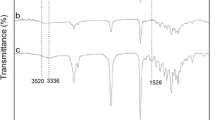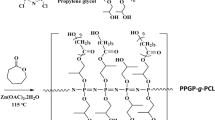Abstract
In this work, the biocompatibility of a biomimetic, fully biodegradable ionomer phosphorylcholine (PC)-functionalized poly(butylene succinate) (PBS-PC) was investigated by means of hemolysis, platelet adhesion, protein adsorption and cytotoxicity experiments. The reference materials were poly(butylene succinate) (PBS) and chloroethylphosphoryl functionalized poly(butylene succinate) (PBS-Cl). The hemolysis rates (HR) of the leaching solutions of PBS, PBS-Cl and PBS-PC were all lower than the safe value, and the rate of PBS-PC was reduced to 1.07%. Scanning electron microscopy (SEM) measurements showed that platelet adhesion and aggregation were significant on both PBS and PBS-Cl surface. In contrast, very few platelets were observed on PBS-PC surface. Bicinchoninic acid (BCA) measurements revealed that the adsorption amounts of bovine serum albumin (BSA) and bovine plasma fibrinogen (BPF) on PBS-PC surface were 52% and 72% reduction respectively compared with those on PBS surface. Moreover, non-cytotoxicity of both PBS-PC particles and its leaching solution was suggested by MTT assay using mouse L929 fibroblast cells. All the results demonstrated that the biocompatibility of PBS could be greatly improved by PC end-capping strategy. This PC functionalized polyester may have potential applications in biological environments as a novel carrier for controlled drug release and scaffold for tissue engineering.
Similar content being viewed by others
References
Wang HY, Ji JH, Zhang W, Zhang YH, Jiang J, Wu ZW, Pu SH, Chu PK. Biocompatibility and bioactivity of plasma-treated biodegradable poly(butylene succinate). Acta Biomater, 2009, 5: 279–287
Jagur-Grodzinski J. Polymers for tissue engineering, medical devices, and regenerative medicine. Concise general review of recent studies. Polym Adv Technol, 2006, 17: 395–418
Wong HM, Yeung KWK, Lam KO, Tama V, Chu PK, Luk KDK, Cheung KMC. A biodegradable polymer-based coating to control the performance of magnesium alloy orthopaedic implants. Biomaterials, 2010, 31: 2084–2096
Qu X, Cui WJ, Yang F, Min CC, Shen H, Bei JZ, Wang SG. The effect of oxygen plasma pretreatment and incubation in modified simulated body fluids on the formation of bone-like apatite on poly(lactide-co-glycolide) (70/30). Biomaterials, 2006, 28: 9–18
Amato I, Ciapetti G, Pagani S, Marlett G, Satriano C, Baldin N, Granchi D. Expression of cell adhesion receptors in human osteoblasts cultured on biofunctionalized poly-(ɛ-caprolactone) surfaces. Biomaterials, 2007, 28: 3668–3678
Yang J, Tian WS, Li QB, Li Y, Cao AM. Novel biodegradable aliphatic poly(butylene succinate-co-cyclic carbonate)s bearing functionalizable carbonate building blocks: ii. Enzymatic biodegradation and in vitro biocompatibility assay. Biomacromolecules, 2004, 5: 2258–2268
Ba CY, Yang J, Hao QH, Liu XY, Cao AM. Syntheses and physical characterization of new aliphatic triblock poly(L-lactide-b-butylene succinate-b-L-lactide)s bearing soft and hard biodegradable building blocks. Biomacromolecules, 2003, 4: 1827–1834
Shih YF, Chen LS, Jeng RJ. Preparation and properties of biodegradable PBS/multi-walled carbon nanotube nanocomposites. Polymer, 2008, 49: 4602–4611
Shirahama H, Kawaguchi Y, Aludin MS, Yasuda H. Synthesis and enzymatic degradation of high molecular weight aliphatic polyesters. J Appl Polym Sci, 2001, 80: 340–347
Ishii M, Okazaki M, Shibasaki Y, Ueda M, Teranishi T. Convenient synthesis of aliphatic polyesters by distannoxane-catalyzed polycondensation. Biomacromolecules, 2001, 2: 1267–1270
Yang J, Hao QH, Liu XY, Ba CY, Cao AM. Novel biodegradable aliphatic poly(butylene succinate-co-cyclic carbonate)s with functionalizable carbonate building blocks. 1. Chemical synthesis and their structural and physical characterization. Biomacromolecules, 2004, 5: 209–218
Zhang SP, Zhu XX, Gong YK. Synthesis, characterization and properties of phosphorylcholine functionalized poly(butylene succinate). Acta Chim Sinica, 2009, 67: 1903–1909
Zhang SP, Wang D, Dang Y, Shi SQ, Gong YK. Enzymatic biodegradation and thermal properties of phosphorylcholine functionalized poly(butylene succinate). Chem J Chinese U, 2012, 33: 416–420
Kadoma Y, Nakabayashi N, Masuhara E, Yamauchi J. Synthesis and hemolysis of the polymer containing phosphorylcholine. Kobunshi Ronbunshu, 1978, 35: 423–427
Ishihara K, Fukumoto K, Iwasaki Y, Nakabayashi N. Modification of polysulfone with phospholipid polymer for improvement of the blood compatibility. Part 1. Surface characterization. Biomaterials, 1999, 20: 1545–1551
Watanabe J, Nederberg F, Atthoff B, Bowden T, Hilborn J, Ishihara K. Cytocompatible biointerface on poly(lactic acid) by enrichment with phosphorylcholine groups for cell engineering. Mater Sci Eng C, 2007, 27: 227–231
Yang S, Zhang SP, Winnik FM, Mwale F, Gong YK. Group reorientation and migration of amphiphilic polymer bearing phosphorylcholine functionalities on surface of cellular membrane mimicking coating. J Biomed Mater Res A, 2008, 84: 837–841
Gong M, Yang S, Ma JN, Zhang SP, Winnik FM, Gong YK. Tunable cell membrane mimetic surfaces prepared with a novel phospholipid polymer. Appl Surf Sci, 2008, 255: 555–558
Iwasaki Y, Ishihara K. Phosphorylcholine-containing polymers for biomedical applications. Anal Bioanal Chem, 2005, 381: 534–546
Bi HY, Zhong W, Meng S, Kong JL, Yang PY, Liu BH. Construction of a biomimetic surface on microfluidic chips for biofouling resistance. Anal Chem, 2006, 78: 3399–3405
Futamura K, Matsuno R, Konno T, Takai M, Ishihara K. Rapid development of hydrophilicity and protein adsorption resistance by polymer surfaces bearing phosphorylcholine and naphthalene groups. Langmuir, 2008, 24: 10340–10344
Reisch A, Hemmerle J, Voegel JC, Gonthier E, Decher G, Benkirane-Jessel N, Chassepot A, Mertz D, Lavalle P, Mesini P, Schaaf P. Polyelectrolyte multilayer coatings that resist protein adsorption at rest and under stretching. J Mater Chem, 2008, 18: 4242–4245
Ishihara K, Ando B, Takai M. Phosphorylcholine group-immobilized surface prepared on polydimethylsiloxane membrane by in situ reaction for its reduced biofouling. NanoBiotechnology, 2007, 3: 83–88
Sibarani J, Takai M, Ishihara K. Surface modification on microfluidic devices with 2-methacryloyloxyethyl phosphorylcholine polymers for reducing unfavorable protein adsorption. Colloids Surf B, 2007, 54: 88–93
Nederberg F, Bowden T, Nilsson B, Hong J, Hilborn J. Phosphoryl choline introduces dual activity in biomimetic ionomers. J Am Chem Soc, 2004, 126: 15350–15351
Luo J, Wang LJ, Luo XL. Progress in phospholipid polymers. Polymer materials science and engineering. Polym Mater Sci Eng, 2006, 22: 25–29
Nederberg F, Bowden T, Hilborn J. Synthesis, characterization, and properties of phosphoryl choline functionalized poly ɛ-caprolactone and charged phospholipid analogues. Macromolecules, 2004, 37: 954–965
Meng S, Zhong W, Chou LL, Wang QH, Liu ZJ, Du QG. Phosphorylcholine end-capped poly-ɛ-caprolactone: A novel biodegradable material with improved antiadsorption property. J Appl Polym Sci, 2007, 103: 989–997
Coutinho DF, Pashkuleva IH, Alves CM, Marques AP, Neves NM, Reis RL. The effect of chitosan on the in vitro biological performance of chitosan-poly(butylene succinate) blends. Biomacromolecules, 2008, 9: 1139–1145
Robinson BI, Fletcher JP. Fluoropolymer coated dacron or polytetrafluoroethylene for femoropopliteal bypass grafting: A multicentre trial. ANZ J Surg, 2003, 73: 95–99
Motlagh D, Yang J, Lui KY, Webb AR, Ameer GA. Hemocompatibility evaluation of poly(glycerol-sebacate) in vitro for vascular tissue engineering. Biomaterials, 2006, 27: 4315–4324
Ishihara K, Iwasaki Y, Nakabayashi N. Novel biomedical polymers for regulating serious biological reactions. Mater Sci Eng C, 1998, 6: 253–259
Kallinteri P, Higgins S, Hutcheon GA, St Pourcain CB, Garnett MC. Novel functionalized biodegradable polymers for nanoparticle drug delivery systems. Biomacromolecules, 2005, 6: 1885–1894
Wang WS, Guo YL, Otaigbe JU. Synthesis and characterization of novel biodegradable and biocompatible poly(ester-urethane) thin films prepared by homogeneous solution polymerization. Polymer, 2008, 49: 4393–4398
Zhang SX, Li JA, Song Y, Zhao CL, Zhang XN, Xie CY, Zhang Y, Tao HR, He YH, Jiang Y, Bian YJ. In vitro degradation, hemolysis and MC3T3-E1 cell adhesion of biodegradable Mg-Zn alloy. Mater Sci Eng C, 2009, 29: 1907–1912
Gou ML, Zheng L, Peng XY, Men K, Zheng XL, Zeng S, Guo G, Luo F, Zhao X, Chen LJ, Wei YQ, Qian ZY. Poly(ɛ-caprolactone)-poly(ethylene glycol)-poly(ɛ-caprolactone) (PCL-PEG-PCL) nanoparticles for honokiol delivery in vitro. Int J Pharm, 2009, 375: 170–176
Yabusaki K, Kokufuta E. Aggregation mechanism of blood platelets studied by the time-resolved light scattering method. Langmuir, 2002, 18: 39–41
Chen YM, Tanaka M, Gong JP, Yasuda K, Yamamoto S, Shimomura M, Osada Y. Platelet adhesion to human umbilical vein endothelial cells cultured on anionic hydrogel scaffolds. Biomaterials, 2007, 28: 1752–1760
Smith PK, Krohn RI, Hermanson GT, Mallia AK, Gartner FH, Provenzano MD, Fujmoto EK, Goeke NM, Olson BJ, Klenk DC. Measurement of protein using bicinchoninic acid. Anal Biochem, 1985, 150: 76–85
Huangfu PB, Gong M, Zhang CF, Yang S, Zhao J, Gong YK. Cell outer membrane mimetic modification of a cross-linked chitosan surface to improve its hemocompatibility. Colloids Surf B, 2009, 71: 268–274
Author information
Authors and Affiliations
Corresponding author
Rights and permissions
About this article
Cite this article
Zhang, S., Wang, L., Yang, S. et al. Improved biocompatibility of phosphorylcholine end-capped poly(butylene succinate). Sci. China Chem. 56, 174–180 (2013). https://doi.org/10.1007/s11426-012-4759-7
Received:
Accepted:
Published:
Issue Date:
DOI: https://doi.org/10.1007/s11426-012-4759-7




